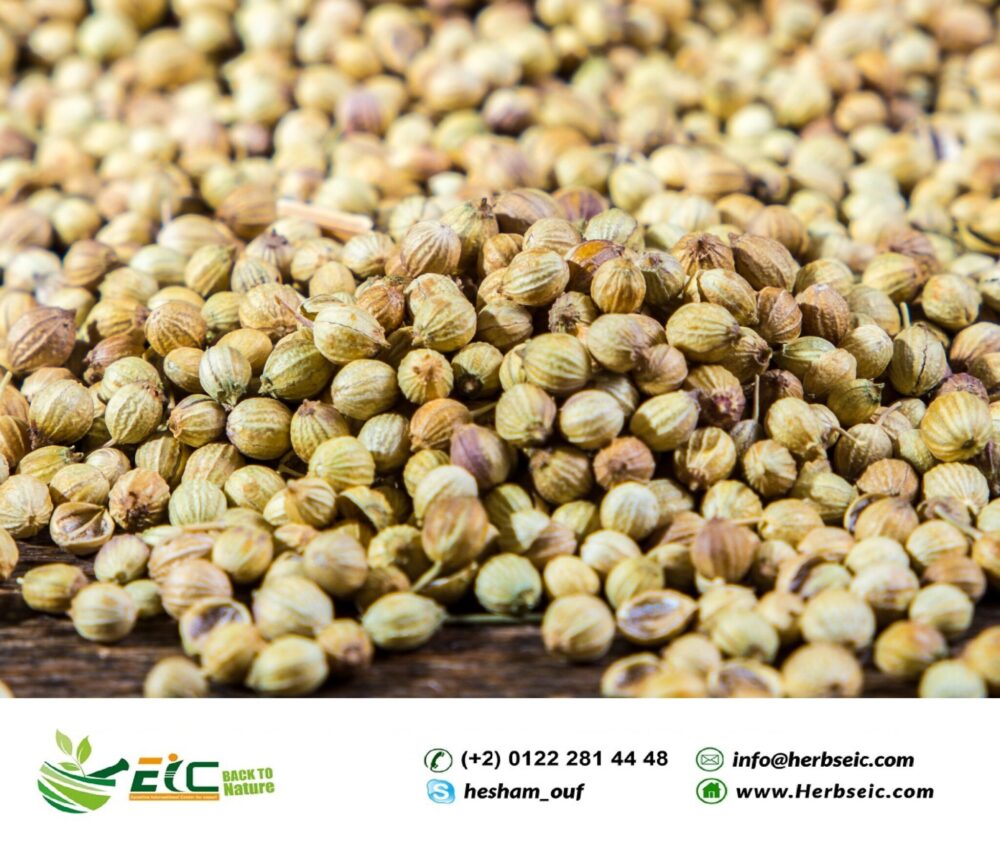At EIC for Export, we proudly supply Bulk Egyptian Coriander Seeds—sun-dried, aromatic seeds with a botanical name Coriandrum sativum, carefully cultivated in Egypt’s fertile soil. As a result of our meticulous sorting and cleaning processes, the seeds retain their natural essential oils, making them ideal for both culinary applications and herbal formulations.
Whether you refer to them as Cilantro seeds, Coriandrum sativum, or simply whole coriander seeds, our product delivers exceptional purity, flavor, and export-grade consistency. In addition, we offer both whole seeds and ground coriander powder, tailored to meet the demands of food processors, spice manufacturers, and international distributors.
Furthermore, our coriander is packed in 25 kg polypropylene bags or customized formats, depending on your operational needs. Consequently, our clients benefit from efficient logistics, full export documentation, and reliable lead times, ensuring a smooth import process across global markets.
Why Choose Our Bulk Egyptian Coriander Seeds?
Furthermore, here’s why our coriander seeds are trusted across food, herbal, and agricultural sectors:
🌿 Pure, Aromatic & Natural: Firstly, our Cilantro seeds are harvested at peak maturity, sun-dried, and machine-cleaned. They feature high oil content, strong aroma, and a citrusy-spicy flavor ideal for spice blends, and Ayurvedic preparations.
📦 Versatile Packaging Options: Available in 20kg or 25kg PP bags or kraft bags. Whether you need bulk cilantro seeds for culinary use, or grinding, we customize the packing and labeling as needed.
🌍 Multiple Applications: Used in coriander cumin blends, coriander fennel mixes, and pickling spices. Also sold as cilantro seeds for valued in herbal medicine and cosmetic formulations.
Specifications for Egyptian Coriander Seeds
| Parameter | Specification |
| Product name | Coriander Seeds – Cilantro seeds |
| Botanical name | Coriandrum sativum (conventional) |
| Moisture | ≤10% |
| Available Types & Colors | Whole, Ground & Pale yellow to brown |
| Packaging | 20:25kg of PP or paper bags |
| Shelf Life | Shelf Life 24 months (if stored in cool, dry conditions) |
| Certifications | FDA, ISO 22000, ISO 9001, MFDS Korea |
Main Applications of our Bulk Egyptian Cilantro Seeds
Our coriander seeds serve a wide range of industries; for example:
- 🍛 Culinary Use: Our whole coriander seeds are widely used in spice mixes, pickles, and cooking. From ground coriander powder in curries to toasted coriander in marinades, our product fits global flavor systems.
- 🌱 Planting & Agriculture: Suitable for growing cilantro (coriander leaves) at home or in large-scale farming. Our Egyptian Cilantro seeds are viable, high in germination, and compatible with various coriander varieties.
- 💊 Health & Wellness: Coriander is known for supporting digestion, liver health, and blood pressure balance. So, they use it in teas, infusions, and functional supplements. Also blended with fennel, cumin, or black seed.
Shipping & Documentation of our Bulk Egyptian Cilantro Seeds
All exports include complete and traceable documentation:
- Commercial Invoice
- Packing List
- Bill of Lading (B/L)
- Phytosanitary Certificate
- Certificate of Origin (COO)
- Fumigation Certificate
- Silica Gel Inclusion (for moisture protection)
- Full Insurance Policy
- Importer Security Filing (ISF file for USA)
Our Export Markets for our Bulk Egyptian Coriander Seeds
We export bulk Egyptian coriander seeds to clients in the USA, Brazil, Argentina, Poland, Greece, Iraq, Lebanon, Morocco, UAE, and Malaysia. Thus, our buyers include spice processors, herb brands, plant nurseries, and functional food producers.
Product Highlights: Bulk Egyptian Coriander Seeds
Moreover, we process our Egyptian Cilantro seeds to meet global standards, for example:
- ✅ 100% pure Coriandrum sativum.
- ✅ Available as whole or powdered coriander.
- ✅ Suitable for cooking, herbal use, or planting cilantro.
- ✅ HS Code: 09/09/21/00/00.
Why Work with EIC?
✅ Firstly, over 15 Years of experience in herb & spice export.
✅ Direct sourcing from Egyptian farms.
✅ Competitive coriander seed price per kg or MT.
✅ Moreover, Flexible packaging & documentation support.
✅ Lastly, reliable global shipping.
Order Egyptian Corainder Seeds Today
📦 Minimum Order: 18 MT (flexible for regular buyers)
📅 Lead Time: 12–14 days after order confirmation
🎯 Special Offer: Free documentation and fumigation, additionally, insurance for orders over 25 MT.
📧 Contact us for a custom quote: info@herbseic.com
🌐 www.herbseic.com
📱WhatsApp: +20 (012-22814448)
📍 Based in Fayoum, Egypt.
👉 Fast response within 24 hours guaranteed.
🎥 Lastly, watch our YouTube Channel for coriander seed quality.


Reviews
There are no reviews yet.